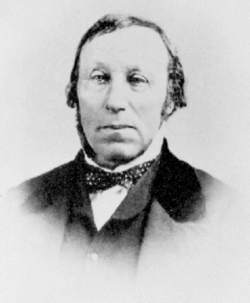Chilcotin War facts for kids
Quick facts for kids Chilcotin War |
|||||
|---|---|---|---|---|---|
 Alfred Waddington, the sponsor of the road construction |
|||||
|
|||||
| Belligerents | |||||
| White workers working for Alfred Waddington | Tsilhqot'in (Chilcotin) people | ||||
| Casualties and losses | |||||
| 14–19 killed |
15+ wounded and killed 5 arrested and hanged1 |
||||
| 1The five arrested were allegedly tricked into meeting Colonial officials under the false pretense of a truce. | |||||
The Chilcotin War, also known as the Chilcotin Uprising, happened in 1864. It was a conflict between the Tsilhqot'in people and road construction workers in British Columbia. During this time, 14 workers building a road for Alfred Waddington were killed. Some other men near Anahim Lake and a settler at Puntzi Lake also lost their lives.
Contents
The Chilcotin War: A Historical Conflict
Why the Conflict Started
In 1862, a man named Alfred Waddington wanted to build a wagon road from Bute Inlet to Fort Alexandria. This road would connect to the Cariboo Road and lead to the goldfields at Barkerville. Waddington believed his road would make travel much faster. It would cut land travel from 359 miles (578 km) to 185 miles (298 km). This would save many days compared to the route through Yale.
The Tsilhqot'in people, like many other First Nations, had recently suffered greatly. A terrible disease, the 1862 Pacific Northwest smallpox epidemic, had spread through their communities. Many Indigenous people believed this disease was spread on purpose. They thought it was a way to take their land.
Arrest and Execution of Tsilhqot'in Leaders
In 1864, some Tsilhqot'in leaders, including Chief Alexis and a man named Klattasine, met with colonial officials. The Tsilhqot'in chiefs believed they were going to peace talks. However, when Klattasine, Tellot, and others arrived, they were arrested. They claimed they had been promised safety, but this was denied.
Five Tsilhqot'in men were arrested and charged. These were Tellot, Klattasine, Tah-pitt, Piele, and Chessus. They were tried in September 1864. During the trial, Klattasine stated they were fighting a war, not committing a crime. Despite this, they were found guilty and sentenced to be hanged. The day they were executed is now a day of mourning for the Tsilhqot'in Nation. Another chief, Chief ʔAhan, was executed a year later.
People had different ideas about why the conflict happened. Waddington thought it was fear of smallpox. Others believed it was because the Tsilhqot'in were starving while the workers had plenty of food. Judge Begbie thought the main reason was concern over land rights. There were also complaints about graves being disturbed and water sources being interfered with.
Review of the Trial and Exoneration
The Tsilhqot'in Nation always said that the violence was a war between two independent nations. They believed they were protecting their lands and way of life. In 2018, Prime Minister Trudeau said that the Tsilhqot'in War Chiefs were heroes to their people.
In 1993, a report suggested that the British Columbia government should apologize. As a result, the Attorney General apologized for the hanging of the Chilcotin chiefs. The government also put up a plaque where the hangings happened.
In 2014, the British Columbia government officially cleared the Chilcotin leaders of any wrongdoing. Premier Christy Clark said they were "fully exonerated." Prime Minister Justin Trudeau did the same for the Government of Canada in 2018. During his speech, the current Tsilhqot'in Chiefs were invited into the House of Commons. This was the first time an Indigenous Nation was invited there. Clark also mentioned that there was a sign that smallpox might have been spread on purpose.
In November 2018, Trudeau visited the Tsilhqot'in people's land. He was the first prime minister to do so. He made another apology speech to the community and its leaders. Trudeau rode into the valley on a black horse, which symbolized the horses ridden by the chiefs who were wrongly executed. He also took part in a smudging ceremony.
In Media
The Chilcotin War is featured in the historical fiction book A Place Called Sorry by Donna Milner.
See also
- List of massacres in Canada

